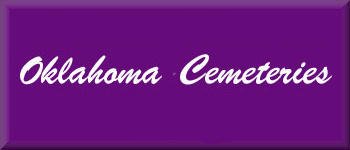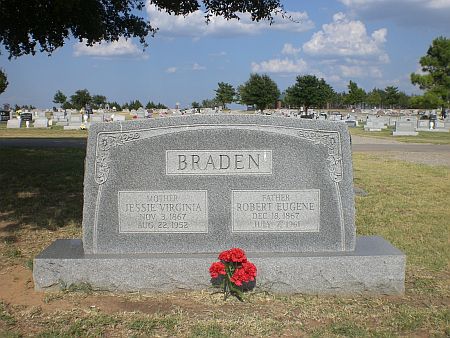
|  |  |

|  |  |

Indian Pioneer Interview November 1, 1937 Robert Eugene Braden Interview #9063 Field Worker: Maurice R. Anderson Date: November 1, 1937 Name: Mr. R.E. Braden Residence: 729 North Chickasaw, Pauls Valley, Oklahoma Date of Birth: December 18, 1867 Place of Birth: Arkansas Father: A.J. Braden, born in Tennessee Mother: Sarah E. Crawford, born in Arkansas I was born in 1867 in Arkansas. I came to the Indian Territory with my father and mother. We came overland by wagon and ox team. I was only six years old but I remember the trip. We stopped at Boggy Depot for a short while on account of bad weather. Boggy Depot was located on Boggy Creek in the Choctaw nation and Captain Hester owned the general merchandise store there. My father worked for Mr. Hester while we were there. Captain Hester had come to this country with the early Mississippi Choctaws. He was a white man but had been adopted by the Choctaw Tribe. Around Boggy Depot lived some of the best educated people of the Choctaw Tribe. A Mr. Thompson was living at Boggy Depot. He was a white man and had come to this country with the Choctaw Indians. He was making salt for the Choctaw Indian people while we lived there. Forbes Leflore, Dave Folsom and their families were of the better class of the Choctaw Indians living around Boggy. We lived there until the rainy season was over, about 1873, and we moved to Smith Pauls Valley, located on the Washita River in the Chickasaw nation. My father began farming for Smith Paul. At that time Smith Paul had about two thousand acres of land under cultivation and had cattle ranging from the south bank of the Washita River at Pauls Valley to the Arbuckle Mountains. Frank Miller and Mr. Green were in the general merchandise business and their store was about a mile south of where the present location of Pauls Valley is today. Ambrose Klinglesmith owned a blacksmith shop and did the horse-shoeing for the Government on the stage line. Russ and Abe Mitchell, W.G. Kimberlin and Zach Gardner were large farmers living around this valley. Charley Wanton owned a large ranch known as the "Crucho Ranch" located on Crucho Creek, about six miles east of where Oklahoma City is now located. At this time that part of the country was called "No Man's Land". E.P. Baker hauled freight for the Government with mule teams from Caddo to Fort Sill. My father farmed one year on the Smith Paul farm. In 1875 he met a man named Al Doolittle, who owned five freight wagons and forty head of oxen. At that time there were no settlements west of Pauls Valley except stage stops and government forts, Fort Sill, Fort Reno, Fort Supply and Fort Dodge, Kansas. This wagon train was contacted several times by the Indians, but there were no fights. It took from early spring to late fall in1875 to reach Dodge City, Kansas. At this place my father, with his family, left the wagon train and returned to Pauls Valley where he went back to farming on the Smith Paul farm. He farmed there until 1884. Until 1884 there were no schools or churches around Pauls Valley. In 1884, my brother, C.F. Braden, went to Sherman, Texas, to attend school and I went to Siloam Springs, Arkansas. I made this trip on horseback and was there in school two years. At the end of my two years schooling, which was my first school to attend, I returned to my family who were then living near Whitebead Hill. I found the Whitebead Community had built a subscription school and had also built a church house. This church was a Methodist Church and the school was called the Pierce Institute. At this school I received another year's schooling. The Santa Fe Railroad was built through the Chickasaw Nation in the latter part of 1886 and the first of 188 After the railroad was built through here the Miller and Green store, then owned by Martin and Grant was moved near where the depot is now located. Tom Martin and C.J. Grant were the new owners of this store. After the store was moved to the present location of Pauls Valley I went to work for Martin and Grant as clerk in this store and worked for them until the fall of 1888. I took the last sack of mail brought into Pauls Valley by stage and the first sack of mail brought in by train. The post office at that time was still located in the old Miller and Green store and C.J. Grant was the postmaster. I was married to Miss Jessie Manning in 1888. She had been employed at a school in Anadarko two years before we married. The Pioneers who settled this country wee fine men and women. The country was controlled by Federal law but each community had its code of rules. the men were not allowed to beat their bills or talk about the women folks without being taken care of by the community in which they lived. All cases such as murder and theft were tried in Federal Court at Fort Smith or at Paris, Texas. I made the run when Oklahoma opened in 1889, and staked a claim eight miles east and four miles south of Oklahoma City. Before this run my brother had been working on the Crucho Ranch, east of where Oklahoma City is now and he wanted me to stake a claim near this ranch if I could. When the word was given I headed in the direction my brother had told me about. I only missed this place a few miles. I settled on Crucho Creek all right but not on the location my brother wanted me to. I put up some improvements, enough to hold my claim. I went to work selling drygoods for R.G. Hall and son of Purcell. I made the Cherokee Strip run and the run at the opening of the Comanche Country. When Oklahoma City began to build up I was superintendent of the first water line laid in Oklahoma City. I returned to Pauls Valley in 1895 and built my home on what is now Chickasaw Street. I went into the hardware business at Pauls Valley in 1900 and operated this business until 1904. I was water superintendent of Pauls Valley for a number of years. |
This site may be freely linked, but not duplicated in any way without consent.
All rights reserved! Commercial use of material within this site is prohibited!
© 2000-2024 Oklahoma CemeteriesThe information on this site is provided free for the purpose of researching your genealogy. This material may be freely used by non-commercial entities, for your own research, as long as this message remains on all copied material. The information contained in this site may not be copied to any other site without written "snail-mail" permission. If you wish to have a copy of a donor's material, you must have their permission. All information found on these pages is under copyright of Oklahoma Cemeteries. This is to protect any and all information donated. The original submitter or source of the information will retain their copyright. Unless otherwise stated, any donated material is given to Oklahoma Cemeteries to make it available online. This material will always be available at no cost, it will always remain free to the researcher.